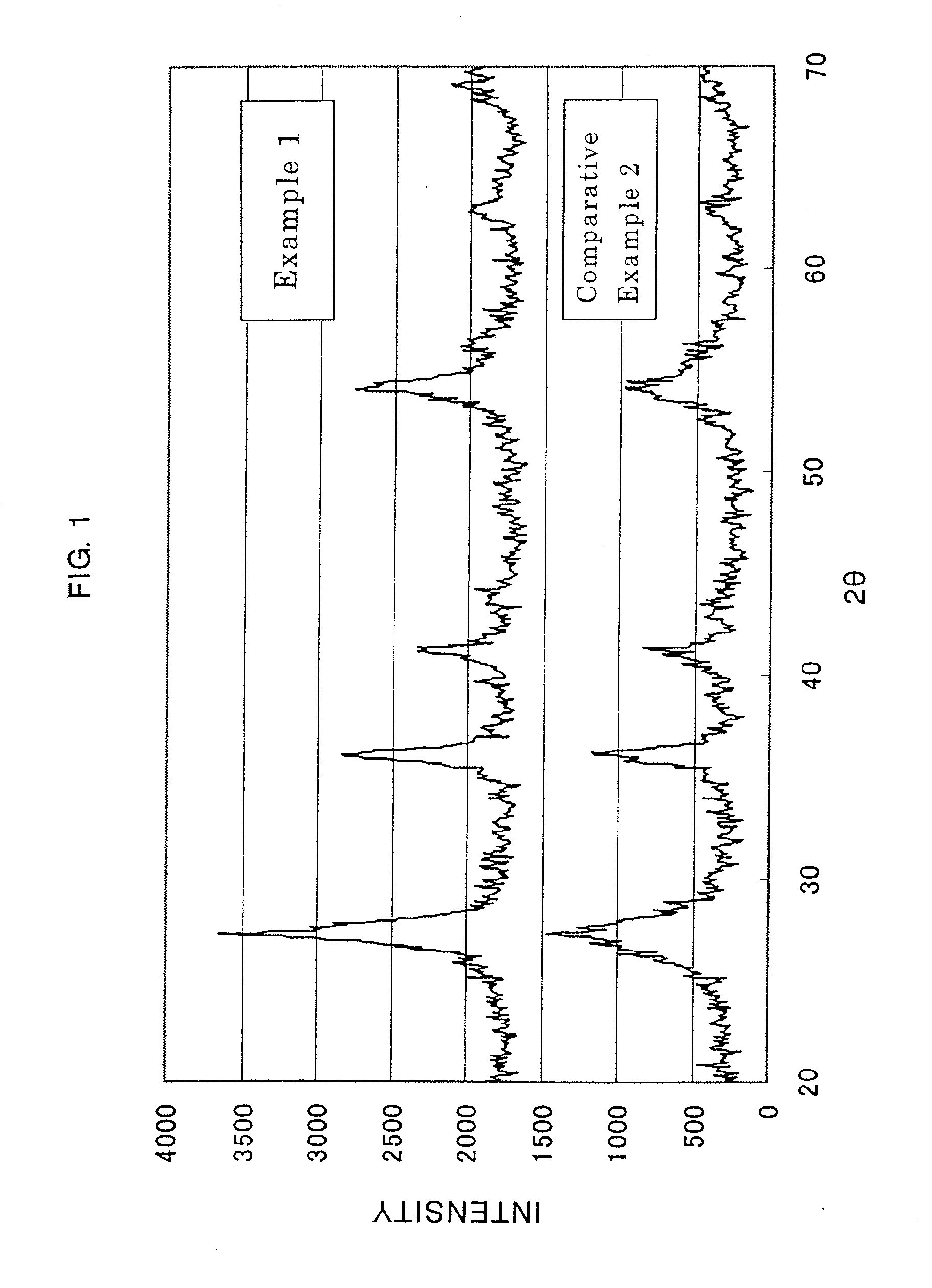Dispersion of particles of rutile titanium oxide, process for producing the same, and use of the same
a technology dispersion process, which is applied in the field of dispersion of particles of rutile titanium oxide, a process for producing the same, can solve the problems of inability to use such an application of resin molding or coating agent for hard coating, low crystallinity of titanium oxide particles, and inability to increase crystallinity while the particles are in the process of dispersing, etc., to achieve easy and uniform dispersion of titanium oxide, high crystallinity rate and stability ratio ratio ratio ratio ratio ratio ratio ratio ratio ratio ratio ratio ratio ratio ratio ratio ratio ratio ratio ratio ratio ratio ratio ratio ratio ratio ratio ratio ratio ratio ratio ratio ratio ratio ratio ratio ratio ratio ratio ratio ratio ratio ratio ratio ratio ratio ratio ratio ratio ratio ratio ratio ratio ratio ratio ratio ratio ratio ratio ratio ratio ratio ratio ratio ratio ratio ratio ratio ratio ratio ratio ratio ratio ratio ratio ratio ratio ratio ratio ratio ratio ratio ratio ratio ratio ratio ratio ratio ratio ratio ratio ratio ratio ratio ratio ratio ratio ratio ratio ratio ratio ratio ratio ratio ratio ratio ratio ratio ratio ratio ratio ratio ratio ratio ratio ratio ratio ratio ratio ratio ratio ratio ratio ratio ratio ratio ratio ratio ratio ratio ratio ratio ratio ratio ratio ratio ratio ratio ratio ratio ratio ratio ratio ratio ratio ratio ratio ratio ratio ratio ratio ratio ratio ratio ratio ratio ratio ratio ratio ratio ratio ratio ratio ratio ratio ratio ratio ratio ratio ratio ratio ratio ratio ratio ratio ratio ratio ratio ratio ratio ratio ratio ratio ratio ratio ratio ratio ratio ratio ratio ratio ratio ratio ratio ratio ratio ratio ratio ratio ratio ratio ratio ratio ratio ratio ratio ratio ratio ratio ratio ratio ratio ratio ratio ratio ratio ratio ratio ratio ratio ratio ratio ratio ratio ratio ratio ratio ratio ratio ratio ratio ratio ratio ratio ratio ratio ratio ratio ratio ratio ratio ratio ratio ratio ratio ratio ratio ratio ratio ratio ratio ratio ratio ratio ratio ratio ratio ratio ratio ratio ratio ratio ratio ratio ratio ratio ratio ratio ratio ratio ratio ratio ratio ratio ratio ratio ratio ratio ratio ratio ratio ratio ratio ratio ratio ratio ratio ratio ratio ratio ratio ratio ratio ratio ratio ratio ratio ratio ratio ratio ratio ratio ratio ratio ratio ratio ratio ratio ratio ratio ratio ratio ratio ratio ratio ratio ratio ratio ratio ratio ratio ratio ratio ratio ratio ratio ratio ratio ratio ratio ratio ratio ratio ratio ratio ratio ratio ratio ratio ratio ratio ratio ratio ratio ratio ratio ratio ratio ratio ratio ratio ratio ratio ratio ratio ratio ratio ratio ratio ratio ratio ratio ratio ratio ratio ratio ratio ratio ratio ratio ratio ratio ratio ratio ratio ratio ratio ratio ratio ratio ratio ratio ratio ratio ratio ratio ratio ratio ratio ratio ratio ratio ratio
- Summary
- Abstract
- Description
- Claims
- Application Information
AI Technical Summary
Benefits of technology
Problems solved by technology
Method used
Image
Examples
example 1
First Step
[0058]An aqueous solution of titanium tetrachloride was diluted with water so that it had titanium tetrachloride in an amount of 200 g / L in terms of titanium oxide and chloride ions in a concentration of 8.3 mole / L. One liter of the aqueous solution of titanium tetrachloride was placed in a separable flask equipped with a reflux apparatus, and it was heated at a boiling point (110° C.) for 2 hours so that the titanium tetrachloride is hydrolyzed, thereby a slurry containing precipitated particles of rutile titanium oxide was obtained.
Second Step
[0059]The slurry was filtered through a filter paper made of glass fiber having a collection diameter of 300 nm, and unreacted titanium tetrachloride and dissolved components were removed. The thus obtained particles of rutile titanium oxide were repulped in water, and an aqueous solution of sodium hydroxide was added to the obtained slurry until it had a pH of 7.0. The resulting slurry was then filtered through a filter paper made ...
example 2
[0065]In the fifth step of Example 1, hydrochloric acid was used in place of nitric acid as a peptizer, and otherwise in the same manner as in Example 1, a dispersion of particles of rutile titanium oxide was obtained.
example 3
[0066]In the third step of Example 1, acetic acid was added in an amount of 90 parts by mole per 100 parts by mole of titanium oxide, and otherwise in the same manner as in Example 1, a dispersion of particles of rutile titanium oxide was obtained.
PUM
| Property | Measurement | Unit |
|---|---|---|
| particle size distribution | aaaaa | aaaaa |
| particle size distribution | aaaaa | aaaaa |
| specific surface area | aaaaa | aaaaa |
Abstract
Description
Claims
Application Information
 Login to View More
Login to View More - R&D
- Intellectual Property
- Life Sciences
- Materials
- Tech Scout
- Unparalleled Data Quality
- Higher Quality Content
- 60% Fewer Hallucinations
Browse by: Latest US Patents, China's latest patents, Technical Efficacy Thesaurus, Application Domain, Technology Topic, Popular Technical Reports.
© 2025 PatSnap. All rights reserved.Legal|Privacy policy|Modern Slavery Act Transparency Statement|Sitemap|About US| Contact US: help@patsnap.com

